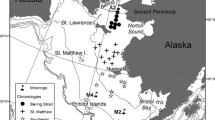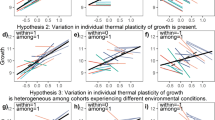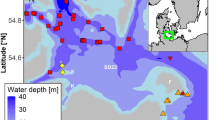Abstract
We examine the seasonal variation in otolith increment formation in southern North Sea cod as a means of monitoring how changes in sea temperature over the past 20 years have affected cod in the wild. Seasonal opaque zone formation was related to winter and early spring. Timing of opaque zone formation was not influenced by either temperature or fish length, but increasing age led to slightly earlier but slower opaque zone formation. In contrast, there was a clear shift in the timing of translucent zone formation with temperature. In warm years, translucent growth occurs up to 22 days earlier than in colder periods. Increasing age and smaller size-at-age resulted in an earlier transition from opaque to translucent edge formation. Translucent zone formation appears indicative of increasing metabolic stress, and the earlier onset provides direct evidence of the impact of increasing sea temperatures on wild North Sea cod stocks.





Similar content being viewed by others
References
Beaugrand G, Kirby RR (2010) Climate, plankton and cod. Glob Chang Biol 16:1268–1280
Beaugrand G, Brander KM, Lindley A, Souissi S, Reid PC (2003) Plankton effect on cod recruitment in the North Sea. Nature 426:661–664
Beaugrand G, Edwards M, Brander K, Luczak C, Ibanez F (2008) Causes and projections of abrupt climate-driven ecosystem shifts in the North Atlantic. Ecol Lett 11:1157–1168
Beckman DW, Wilson CA (1995) Seasonal timing of opaque zone formation in fish otoliths. In: Secor DH, Dean JM, Campana SE (eds) Recent developments in fish otolith research. University of South Carolina Press, Columbia, pp 27–44
Bedford BC (1983) A method for preparing sections of large numbers of otoliths embedded in black polyester resin. J Cons Int Explor Mer 41:4–12
Björnsson B, Steinarsson A (2002) The food-unlimited growth rate of Atlantic cod (Gadus morhua). Can J Fish Aquat Sci 59:494–502
Björnsson B, Steinarsson A, Oddgeirsson M (2001) Optimal temperature for growth and feed conversion of immature cod (Gadus morhua L.). ICES J Mar Sci 58:29–38
Blacker RW (1974) Recent advances in otolith studies. In: Jones FRH (ed) Sea fisheries research. Wiley, New York, pp 67–90
Brander KM (1995) The effect of temperature on growth of Atlantic cod (Gadus morhua L.). ICES J Mar Sci 52:1–10
Brett JR (1979) Environmental factors and growth. In: Hoar WS, Randall DJ, Brett JR (eds) Fish physiology, vol 8. Academic Press, London, pp 559–675
Chambers JM, Hastie TJ (1992) Statistical models in S. Chapman and Hall, New York
Claireaux G, Webber DM, Lagardere JP, Kerr SR (2000) Influence of water temperature and oxygenation on the aerobic metabolic scope of Atlantic cod (Gadus morhua). J Sea Res 44:257–265
Clark RA, Fox CJ, Viner D, Livermore M (2003) North Sea cod and climate change––modelling the effects of temperature on population dynamics. Glob Chang Biol 9:1669–1680
Colosimo A, Giuliani A, Maranghi F, Brix O, Thorkildsen S, Fischer T, Knust R, Pörtner HO (2003) Physiological and genetical adaption to temperature in fish populations. Cont Shelf Res 23:1919–1928
Dannevig E (1956) The influence of temperature on the formation of zones in scales and otoliths of young cod. Fiskdir Skr Ser Hav 9:1–16
Drinkwater KF (2005) The response of Atlantic cod (Gadus morhua) to future climate changes. ICES J Mar Sci 62:1327–1337
Easey MW, Millner RS (2008) Improved methods for the preparation and staining of thin sections of fish otoliths for age determination. Sci Ser Tech Rep. 143 Cefas, Lowestoft
Edwards M, Richardson AJ (2004) The impact of climate change on the phenology of the plankton community and trophic mismatch. Nature 430:881–884
Graham M (1929) Studies on age determination in fish. 1. A study of the growth-rate of codling (Gadus callarias L.) on the Inner Herring Trawling Ground. MAFF Fishery Invest Ser II, XI, Lowestoft
Greve W, Prinage S, Zidowitz H, Nast J, Reiners F (2005) On the phenology of North Sea ichthyoplankton. ICES J Mar Sci 62:1216–1223
Høie H, Folkvord A (2006) Estimating the timing of growth rings in Atlantic cod otoliths using stable oxygen isotopes. J Fish Biol 68:826–837
Høie H, Folkvord A, Mosegaard H, Li L, Worsøe Clausen LA, Norberg B, Geffen AJ (2007) Restricted fish feeding reduces cod otolith opacity. J Appl Ichthyol 24:138–143
Høie H, Millner RS, McCully S, Nedreaas KH, Pilling GM, Skadal J (2008) Latitudinal differences in the timing of otolith growth: a comparison between the Barents Sea and southern North Sea. Fish Res 96:319–322
Hüppop O, Hüppop K (2003) North Atlantic oscillation and timing of spring migration in birds. Proc R Soc Lond B 270:233–240
Hüssy K, Mosegaard H (2004) Atlantic cod (Gadus morhua) growth and otolith accretion characteristics modelled in a bioenergetics context. Can J Fish Aquat Sci 61:1021–1031
Hüssy K, Mosegaard H, Jessen F (2004) Effect of age and temperature on amino acid composition and the content of different protein types of juvenile Atlantic cod (Gadus morhua) otoliths. Can J Fish Aquat Sci 61:1021–1031
ICES (2008) Report of the ICES advisory committee 2008. ICES Advice, 2008. Book 6, 326 pp
Jobling M (1988) A review of the physiological and nutritional energetics of cod, Gadus morhua L., with particular reference to growth under farmed conditions. Aquaculture 70:1–19
Jordan AD, Lampe JF, Grisdale-Helland B, Helland SJ, Shearer KD, Steffansen JF (2006) Growth of Atlantic cod (Gadus morhua L.) with different haemoglobin subtypes when kept near their temperature preferenda. Aquaculture 257:44–52
Kirby RR, Beaugrand G (2009) Trophic amplification of climate warming. Proc R Soc Lond, Ser B Biol Sci 276:4095–4103
McKenzie RA (1938) Cod take smaller bites in ice-cold water. Atlantic Prog Rep Fish Res Bd Can 22:12–14
Morgan MJ, Rideout RM, Colbourne EB (2010) Impact of environmental temperature on Atlantic cod Gadus morhua energy allocation to growth, condition and reproduction. Mar Ecol Prog Ser 404:185–195
Neat F, Righton D (2007) Warm water occupancy by North Sea cod. Proc R Soc B 274:789–798
Neat FC, Wright PJ, Zuur AF, Gibb IM, Gibb FM, Tulett D, Righton DA, Turner RJ (2006) Residency and depth movements of a coastal group of Atlantic cod (Gadus morhua L.,). Mar Biol 148:643–654
Neat FC, Wright PJ, Fryer RJ (2008) Temperature effects on otolith pattern formation in Atlantic cod Gadus morhua. J Fish Biol 73:2527–2541
Neilson JD, Geen GH (1985) Effects of feeding regimes and diel temperature cycles on otolith increment formation in juvenile Chinook salmon, Onchorhyncus tshawytscha. Fish Bull US 83:91–101
O’Brien CM, Fox CJ, Planque B, Casey J (2000) Climate variability and North Sea cod. Nature 404:142
Pilling GM, Millner RS, Easey MW, Maxwell DL, Tidd AN (2007) Phenology and North Sea cod Gadus morhua L.: has climate change affected otolith annulus formation and cod growth? J Fish Biol 70:584–599
Planque B, Fox CJ, Saunders MA, Rockett P (2003) On the prediction of short term changes in the recruitment of North Sea cod (Gadus morhua) using statistical temperature forecasts. Sci Mar 67:211–218
Pörtner HO (2002) Climate variations and the physiological basis of temperature dependent biogeography: systemic to molecular hierarchy of thermal tolerance in animals. Comp Biochem Physiol A 132:739–761
Pörtner HO, Berdal B, Blust R, Brix O, Colosimo A, De Wachter B, Giuliani A, Johansen T, Fischer T, Knust R, Lannig G, Naevdal G, Nedenes A, Nyhammer G, Sartoris FJ, Serendero I, Sirabella P, Thorkildsen S, Zakhartsev M (2001) Climate induced temperature effects on growth performance, fecundity and recruitment in marine fish: developing a hypothesis for cause and effect relationships in Atlantic cod (Gadus morhua) and common eelpout (Zoarces viviparus). Cont Shelf Res 21:1975–1997
R Development Core Team (2003) R: a language and environment for statistical computing. R Foundation for Statistical Computing, Vienna, Austria. ISBN 3-900051-00-3. http://www.R-project.org
Rice JA, Crowder LB, Binkowski FP (1985) Evaluating otolith analysis for bloater Coregonus hoyi: do otoliths ring true? Trans Am Fish Soc 114:532–539
Richardson AJ, Schoeman DS (2004) Climate impact on plankton ecosystems in the Northeast Atlantic. Science 305:1609–1612
Righton D, Metcalfe J, Connolly P (2001) Different behaviour of North and Irish Sea cod. Nature 411:156
Rindorf A, Jensen H, Schrum C (2008) Growth, temperature, and density relationships of North Sea cod (Gadus morhua). Can J Fish Aquat Sci 65:456–470
Schramm HL (1989) Formation of annuli in otoliths of bluegills. Trans Am Fish Soc 118:546–555
Sundby S, Nakken O (2008) Spatial shifts in spawning habitats of Arcto-Norwegian cod related to multidecadal climate oscillations and climate change. ICES J Mar Sci 65:953–962
Trout GC (1954) Otolith growth of the Barents Sea cod. Rapp Proc des Réun Cons Perm int Explor Mer 136:89–102
Wallace W (1914) Report on the age, growth and sexual maturity of plaice in certain parts of the North Sea: an analysis of the English data collected during the period 1903–1911. MAFF Fishery Invest Ser II, II, Lowestoft
Walther G-R, Post E, Convey P, Menzel A, Parmesan C, Beebee T, Fromentin J-M, Hoegh-Guldberg O, Bairlein F (2002) Ecological responses to recent climate change. Nature 416:389–395
Williams T, Bedford BC (1974) The use of otoliths for age determination. In: Bagenal TB (ed) Ageing of fish. Unwin Brothers, England, pp 114–123
Wilson EB (1927) Probable inference, the law of succession, and statistical inference. J Am Stat Assoc 22:209–212
Worley SJ, Woodruff SD, Reynolds RW, Lubker SJ, Lott N (2001) ICOADS release 2.1 data and products. Int J Climatol (CLIMAR-II Special Issue) 25:823–842. doi:10.1002/joc.1166
Acknowledgments
We thank three anonymous reviewers for highly insightful comments on an earlier draft of the manuscript. We thank Mick Easey and Holly Drake for their contributions to the work on otolith edge identification. The study was funded by the UK’s Department for Environment, Food and Rural Affairs under contact MF0433. ICOADS marine temperature data were provided by the NOAA/OAR/ESRL PSD, Boulder, Colorado, USA, from their Web site at http://www.esrl.noaa.gov/psd/.
Author information
Authors and Affiliations
Corresponding author
Additional information
Communicated by M. A. Peck.
Rights and permissions
About this article
Cite this article
Millner, R.S., Pilling, G.M., McCully, S.R. et al. Changes in the timing of otolith zone formation in North Sea cod from otolith records: an early indicator of climate-induced temperature stress?. Mar Biol 158, 21–30 (2011). https://doi.org/10.1007/s00227-010-1539-9
Received:
Accepted:
Published:
Issue Date:
DOI: https://doi.org/10.1007/s00227-010-1539-9




